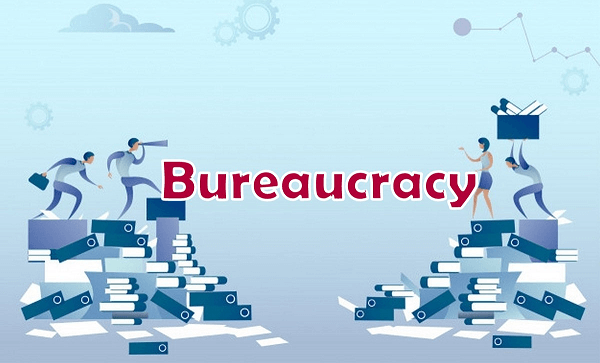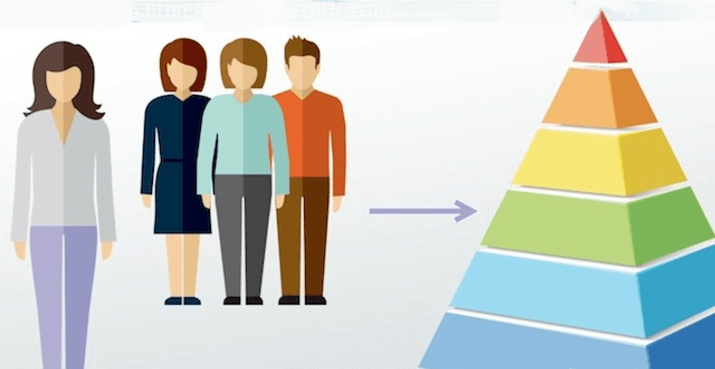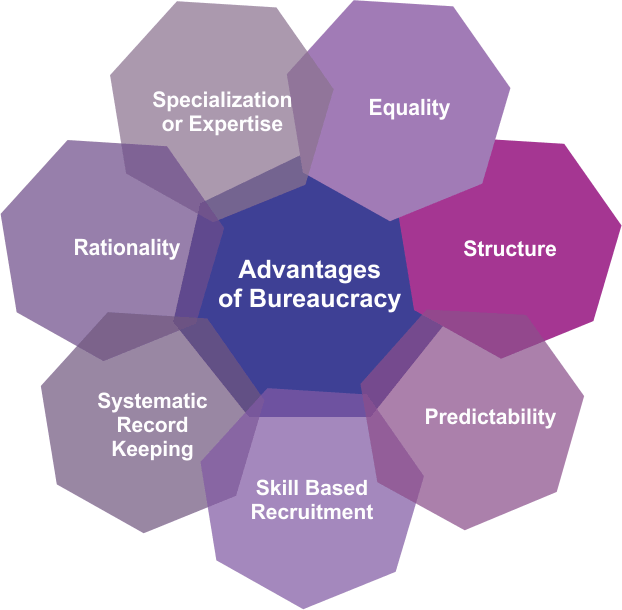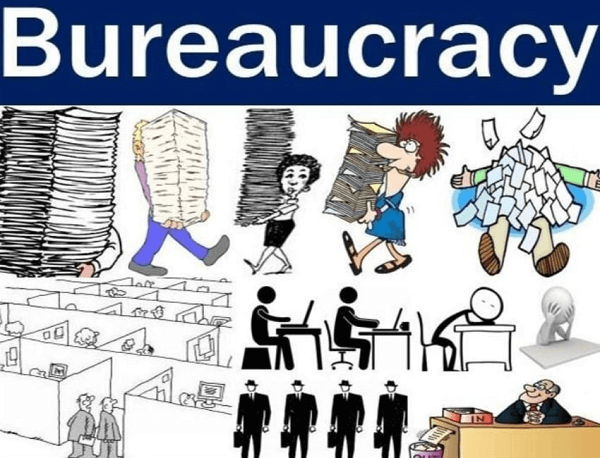Bureaucracy DefinitionA type of organization that has increased in contemporary cultures is bureaucracy. Hierarchical structures, formalized processes, and specialized positions define this administration's style. The administrative procedures used by ancient societies are where bureaucracy started, but the Industrial Revolution and the emergence of contemporary nation-states saw a rise in their use. Today, bureaucracy is typical for big companies, governments, and other institutions. It has benefits and drawbacks, and how well it is managed and adjusted to changing conditions determines its success. Bureaucracy is one of the revolutionary systems back then. It is considered as an effective administration process yet it has its own criticism from people. 
Origins of Bureaucracy in HistoryThe earliest known examples of bureaucracy are in China, Egypt, and Mesopotamia, three early societies. These societies needed a sophisticated administrative structure to run vast empires and complete duties like tax collection, building projects, and war campaigns. The French term "bureau," which means desk or office, is where the word "bureaucracy" itself originates. The French government's administrative structure under Napoleon Bonaparte was described using the word for the first time in the late 18th century. The Industrial Revolution saw a rise in bureaucracy as new technologies and modes of transportation allowed for the coordination of extensive commercial activity. Modern nation-states began to exhibit bureaucracy regularly in the 20th century as governments tried to control and regulate social and economic life. Bureaucracy's historical development is a reaction to the need for effective and efficient administration in complex societies. Despite criticism for its rigidity and inflexibility, bureaucracy has also been charged with fostering consistency, predictability, and accountability in contemporary organizations. Fundamental Features of BureaucracySeveral crucial traits that characterize bureaucracy include: Organizational Hierarchy Bureaucratic organizations have distinct lines of power and responsibility. At the summit, decisions are made and communicated to lower-level employees. Tasks are divided into specialized jobs and responsibilities in bureaucratic organizations. Every employee in the company is responsible for performing a particular task following established protocols. Formalization Bureaucratic organizations rely on formalized rules and procedures to guarantee consistency and fairness. These regulations are frequently documented and upheld by specialized staff members. 
Impersonality Decisions made by bureaucratic organizations are intended to be impartial and objective, free from bias or personal connections. Merit-Based Employment Unlike informal networks or nepotism, bureaucratic organizations usually hire people based on their qualifications and skills. Clear Objectives Bureaucratic structures are made to accomplish particular aims. External parties like shareholders or governmental regulators frequently outline these objectives. Bureaucracy is an organizational structure that places a premium on effectiveness, reliability, and dependability. Although there are some benefits in dependability and responsibility from this, it may also result in rigid, unyielding structures that take time to change to accommodate shifting conditions. The Roles of the BureaucracyIn contemporary countries, bureaucracy performs several crucial tasks, including: Implementation of Policies Bureaucratic agencies enact laws, rules, and government policies. This covers every aspect, from revenue collection to enforcing environmental laws. Coordination of Activities Bureaucratic organizations assist in coordinating complicated activities, such as massive construction projects or efforts to respond to disasters. Bureaucratic organizations can ensure everyone collaborates to achieve a common objective by dividing tasks into specialized roles and responsibilities. Services Offered The public is served by bureaucratic organizations in various ways, including social assistance, healthcare, and education initiatives. Governing Bureaucratic agencies are in charge of governing different facets of society, including the public's health and safety, the ecology, and the economy. Protection of Rights Bureaucratic organizations are essential to guarantee that everyone is handled equally and impartially and safeguard individual rights. Overall, bureaucracy contributes to the organization and functionality of communities and the effective and efficient use of resources. But bureaucracy can also be faulted for being ineffective, rigid, and oblivious to shifting conditions. Bureaucracy TypesThere are two primary types of bureaucracy: centralized and decentralized. Centralized BureaucracyA centralized bureaucracy is one in which the power to make decisions is concentrated at the summit of the hierarchy in one organization or person. Top management makes decisions, which are then communicated to staff members at lesser levels for implementation. Decentralized BureaucracyIn a decentralized bureaucracy, the organization's decision-making power is distributed among various tiers. This style of bureaucracy is typical of democratic societies and businesses that place a high value on employee initiative and collective bargaining. Decisions are made locally by those most familiar with the topic or problem rather than being dictated from above. There are benefits and drawbacks to both centralized and decentralized organizations. Because decisions are made swiftly and consistently, centralized bureaucracies can be more effective and reliable. But they can also be rigid and inflexible and may find adjusting to a shifting environment difficult. On the other hand, decentralized agencies may be more receptive. The Benefits and Drawbacks of BureaucracyPositive Aspects of BureaucracyEfficiency With standardized processes and distinct lines of power, bureaucratic organizations are created to be efficient and dependable. Decision-making may become quicker and more reliable. 
Accountability Bureaucratic organizations are made to answer to exterior stakeholders, like shareholders or government regulators. This can encourage openness and guarantee that choices are made in the general interest. Specialization Specialization enables employees to concentrate on their competence areas in bureaucratic organizations by dividing tasks into specialized roles and responsibilities. Higher levels of productivity and work satisfaction may result from this. Merit-based Employment Rather than relying on personal relationships or nepotism, bureaucratic organizations usually hire people based on their qualifications and skills. This may result in a more talented and varied workforce. Drawbacks of BureaucracyRigidity Bureaucratic organizations tend to be rigid and inflexible, focusing more on adhering to rules and procedures than changing to suit shifting conditions. This may result in hesitation when making decisions and reluctance to change. Impersonality Personal relationships or unique situations may not be considered when decision-making in bureaucratic organizations; instead, they follow the rules and procedures. This may result in a need for more understanding and empathy. Red Tape Bureaucratic organizations may be overburdened with rules and regulations, which could cause delays and annoyance for staff members and clients. Inefficiency With too many layers of administration and unnecessary procedures, bureaucratic organizations can grow bloated and ineffective. This may result in a need for more accountability and resource waste. Overall, bureaucracy positively impacts the promotion of transparency, specialization, and efficiency. It can be faulted for being strict, impersonal, and ineffective. A bureaucratic organization's success relies on its ability to balance these benefits and drawbacks and adjust to shifting conditions. Criticisms of Bureaucracy and Bureaucratic Reform EffortsCriticism of BureaucracyLack of Flexibility Bureaucratic organizations may be resistant to change and sluggish to adjust to changing conditions. Needs to be improved, and lost chances may result from this. Red Tape Overly restrictive rules and regulations can bog down bureaucratic organizations, causing bureaucratic barriers that impede output and aggravate staff members and customers. Impersonality Bureaucratic organizations tend to be impersonal, considering people more like cogs in a machine than as distinct individuals with their wants and needs. Lack of Invention Bureaucratic organizations may be risk-averse and undervalue inventions, which results in a shortened for more innovation and fresh thinking. Efforts at Bureaucratic ReformStreamlining Procedures Procedure simplification and reduction is one strategy for bureaucratic change, making it simpler for people and organizations to work with government agencies. Decentralization Giving more authority to local officials and fostering greater involvement and innovation are two benefits of this method of bureaucratic reform. Privatization Some support privatizing some presently provided services because private companies can do so more effectively and affordably than government organizations. Performance-Based Management Adopting performance-based management procedures, in which organizations are held responsible for achieving specific objectives and results, is another strategy for bureaucratic change. Digital Transformation Governments are increasingly implementing digital technologies to simplify bureaucracy, cut red tape, and raise the calibre of services offered to residents. In general, bureaucratic reform initiatives aim to resolve complaints about bureaucracy and enhance the productivity and effectiveness of governmental organizations. However, several variables, such as political will, public support, and the capacity of governmental institutions to adopt new procedures and technologies, will determine whether these efforts are successful. Examples of Government BureaucracyThe Department of Motor Vehicles (DMV) With standardized processes and distinct lines of authority for issuing driver's licenses, car registrations, and other documents, the DMV is a classic example of bureaucracy. Internal Revenue Service (IRS) Another example of a bureaucratic organization is the Internal Revenue Service (IRS), which enforces tax rules and collects taxes. The Department of Veterans Affairs (VA) The VA is a bureaucratic organization tasked with giving benefits and services to veterans. The VA must follow intricate procedures and regulations to determine eligibility and deliver services. 
The Environmental Protection Agency (EPA) The EPA is a bureaucratic organization with a complicated system of permits and inspections to guarantee compliance with environmental laws and regulations. Examples of bureaucracy in the Private SectorLarge Corporations Many large corporations, like international banks and tech firms, have complex organizational structures with distinct lines of authority and specialized roles and responsibilities. Hospitals Hospitals can also be bureaucratic organizations with standardized processes for handling managerial duties, providing patient care, and adhering to legal requirements. Universities Universities frequently have intricated bureaucratic structures, with various administrative divisions and offices in charge of various operational functions, including admissions, financial assistance, and academic matters. Non-profit Organizations Even non-profit organizations can have bureaucratic processes with standardized methods for program delivery, funding applications, and fundraising. In general, bureaucracy is not just found in governmental institutions; it also exists in businesses in the private sphere. Many organizations exhibit the fundamental elements of bureaucracy, including standardized processes, distinct lines of authority, and specialized roles and responsibilities. Summary and Prospects for BureaucracyBureaucracy is a complicated and nuanced idea with benefits and drawbacks. It's also expected that there will be more initiatives to reduce red tape and adopt more creative and effective governance and organizational administration methods. Finding the ideal balance between the benefits of bureaucracy, such as stability and predictability, and the necessity of flexibility and creativity in a quickly changing world will ultimately be the key to success. Organizational Culture The collective norms, ethics, and values that influence individual and group behaviour and attitudes inside bureaucratic organizations are called bureaucratic culture. These cultural factors can affect many facets of organizational life, such as employee conduct, communication, and decision-making. The following subheadings pertain to the culture of bureaucracy: Norms Bureaucratic norms are unspoken expectations and guidelines that direct behaviour within a company. These standards may cover acceptable attire, working hours, and communication practices. They may also include unspoken guidelines for decision-making, the delegation of power, and dispute resolution. Values Within an organization, behaviour, and decision-making are governed by the common principles and beliefs known as bureaucratic values. Some examples of these principles are accountability, professionalism, and transparency. They can also include values that are more specialized and relevant to the organization's mission and goals, such as public safety or customer service. Ethics Bureaucratic ethics are the moral tenets and values that direct how individuals and groups behave within a company. These ethical principles include honesty, justice, and respect for others. They may also contain more detailed ethical guidelines regarding matters like a conflict of interest, privacy, and the use of public resources. Cultural Alter Because bureaucratic culture is so ingrained in the norms, values, and attitudes of individuals within the company, it can be challenging to alter. Even yet, cultural change is conceivable and frequently needs a concerted effort on the part of leadership, employee involvement, and purposeful communication and reinforcement of new cultural values and practices. Bureaucratic HierarchyOrganizations with a bureaucratic culture may need help to develop creativity, adaptability, and responsiveness. Following are a few subheadings about organizational hierarchy: Organizational Structure Segmenting an organization's structure into departments, divisions, or other units frequently reflects bureaucratic hierarchy. An organizational chart that displays the degrees of power and decision-making within the organization can represent the hierarchy. Levels of Authority A bureaucratic hierarchy often has several tiers of authority, ranging from entry-level staff to senior executives. Higher-level roles have more control over the organization than lower-level positions, and each level has its own duties and decision-making authority. Decision Making Bureaucratic hierarchy may impact how decisions are made inside an organization. Different levels of decision-making exist, with higher-level choices having a bigger effect on the organization as a whole. The organization's structure and objectives will determine whether decision-making is centralized or decentralized. Delegation Higher-level positions frequently assign duties and decision-making authority to lower-level positions in a bureaucratic hierarchy. This delegation can assist in distributing tasks and duties around the business, but it can also result in problems with monitoring and responsibility. Coordination Bureaucratic hierarchy calls for coordination at all organizational levels. Coordination may be required to guarantee that decisions are made quickly and effectively and that everyone in the organization is collaborating to achieve shared objectives. Challenges Organizations may need more support due to bureaucratic structure, particularly regarding interlevel coordination and communication. Additionally, it may result in a rigid organizational structure resistant to innovation and change. Opportunities Bureaucratic hierarchy, however, can also have advantages for businesses, particularly in encouraging uniformity and responsibility. It can be easier to ensure that tasks are given and performed quickly and efficiently and that everyone in the organization contributes to a single goal when there are clear lines of power and decision-making.
Next TopicChlorophyll Definition
|
 For Videos Join Our Youtube Channel: Join Now
For Videos Join Our Youtube Channel: Join Now
Feedback
- Send your Feedback to [email protected]
Help Others, Please Share










